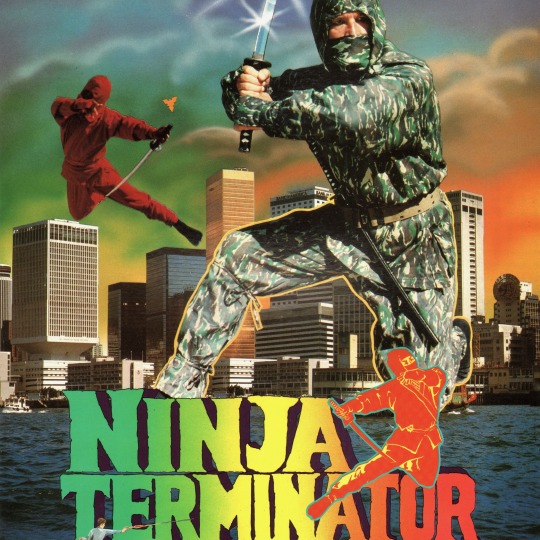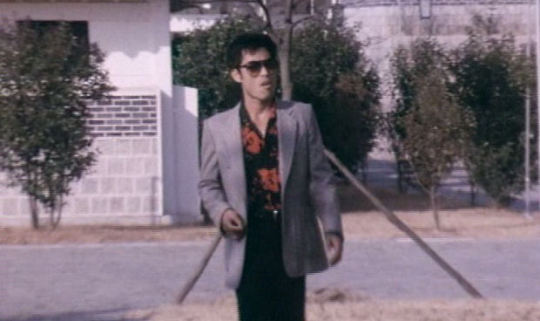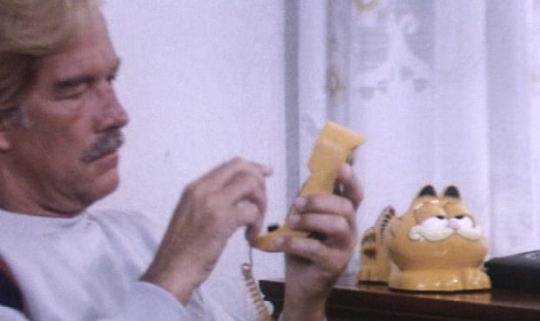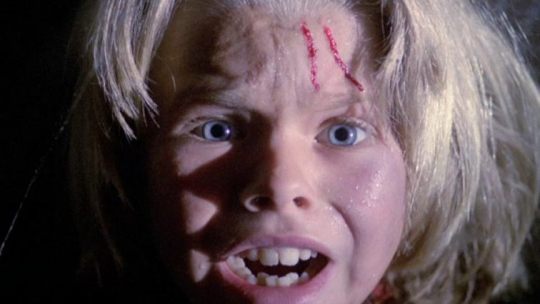#scumintheaisles
Text
SCUM IN THE AISLES #3 (Ninja Terminator)

Sometimes, in order to seek out the weirdest discarded slices of celluloid trash that cinema has to offer, one must leave the confines of their crappy apartment, and go to an actual movie theater. This is a column recounting my excursions into the b-movie wilds. This is Scum in the Aisles!
Look, here’s the thing, Scumbags: I would really like to discuss Godfrey Ho’s Ninja Terminator, which I caught on the big screen at the Drafthouse this past Monday evening. I really would. It was tremendous fun, the audience received the film rapturously, and it lit a fire in me to the point where I now want to watch every Godfrey Ho film that I can find. Oh sure, I can wax rhapsodical about the experience. However, I’m not convinced that the English language has evolved to the point where I can properly explain a Godfrey Ho movie. The closest I can come is, imagine you’re watching a six-year-old playing with a bunch of action figures, and you suddenly start to have a stroke. And even then, knowing that description, I guarantee you that you will not be ready for what Ninja Terminator will do to your mind. You really just have to buy the ticket, and take the ride. I did, and I will never be the same, thank gawd.
Before this month’s Video Vortex, I had only seen one other Godfrey Ho film, 1993’s Undefeatable, starring Cynthia Rothrock. While that film has its quirks, most notably the batshit insane death of its lead villain, it is mostly a fairly by the numbers kung-fu revenge movie, featuring some very impressive stunt work. Little did I know the history and filmmaking style of Godfrey Ho, which I will recount here very quickly, because it is important to understand why Ninja Terminator is such a lysergic cinematic experience.
Godfrey Ho got his start as a first assistant director for Hong Kong’s legendary Shaw Brothers productions. Eventually, he realized that there was a thirst for Hong Kong cinema in the international film market, so he decided to take advantage of that in a very, shall we say, idiosyncratic way. After forming IFD Films & Arts with producer Joseph Lai and a mysterious figure named Tomas Tang (who allegedly died in a fire in the mid-90s, but some believe was secretly Godfrey Ho himself), Ho set about flooding the international film market with no-budget action films, most of which included the word “ninja” in the title. In a ten year period, Ho made roughly 115 films, making him perhaps the most prolific director in all of weirdo cinema. How did he do this? Well, he kinda cheated.

Here’s how a typical Godfrey Ho ninja film came together: Ho would shoot a few minutes of footage featuring caucasian actors in ninja outfits, because caucasian actors meant bigger box office. He would then take an entirely different movie that had been bought by IFD Films & Arts, usually of Korean or Filipino origin, and edit in footage from that film to go alongside his caucasian ninjas, overdub all of the dialogue in English, and try to construct a coherent narrative out of all of these disparate parts. The same footage would get reused over and over again in different iterations for different films, an actor could work with Godfrey Ho once, and end up appearing in twenty of his films. Ho also loved to use unlicensed music; in Ninja Terminator, you can hear snippets of tunes from Pink Floyd and the Star Wars soundtrack, amongst others. The effect of this audacious Frankenstein cinema on your brain is like looking at one of those optical illusion paintings from the nineties: you know that there’s an image in there somewhere, but your brain has to adjust to it.
Apparently Ninja Terminator is one of Ho’s more successful efforts in splicing together what could be called a linear story, which, holy shit, if THIS is an example of a SUCCESSFUL attempt, I can’t wait to see what an abject failure looks like.
So at this point you’ve probably noticed that I’ve been stalling a bit. That’s because, once again, this movie is almost impossible to describe. But I’ll try: there are these three ninjas, two are honkeys, one is “Japanese.” Their master is like, yo, check it out, I’ve got the golden ninja warrior statue, which makes me impervious to harm. The ninjas decide that the statue turns people corrupt and evil, for some reason, so they each escape from the dojo with a piece: each honkey gets an arm, and the “Japanese” guy gets the body, I believe. Some other ninjas try to fight them, but they manage to beat them. Suddenly there’s a two year time jump. The evil ninjas find the “Japanese” ninja and kill him. This leads our head honkey, played by Ho mainstay Richard Harrison, to bring in his right hand man, Jaguar Wong, to protect the dead ninja’s sister, and make sure that the golden ninja warrior doesn’t fall into the wrong hands. Of course, Richard Harrison and Jaguar Wong never meet in person, because Jaguar Wong’s scenes were taken from a Korean drama called The Uninvited Guest.

Now is a good time to discuss some of the film’s…peculiarities. Apparently Ho heard that Garfield (yes, the cat) was very popular in America, so he decided to have Richard Harrison’s character, a middle aged man, discuss business on a Garfield telephone. Needless to say, the entire audience cheered in delighted disbelief the first time this phone appeared. Also, for some reason, whenever Richard Harrison and the other honkey are in their ninja outfits, they also have on a bunch of eyeliner, as if it’s 2004 and they’re going to a My Chemical Romance concert. Then there is the main villain of the film, Tiger Shen. There’s really no easy way to put this, so I’ll just say it. For most of the movie, for no discernible reason, this dude wears a woman’s blonde wig. Like a Gidget, beach blanket bingo wig. It’s hypnotically bizarre. And don’t even get me started on the toy robots that deliver ransom notes and hostage video tapes, because then we’d be here all day.

Basically, the entire film from hereon in is fight scenes. There is a new fight scene roughly every minute or so, which is so over the top and ill-advised, but somehow kinda works. Like, a horror movie with a fresh kill every minute would become tedious, but for some reason, Ho’s unapologetically maximalist take on the kung-fu movie is fascinating to me. Jaguar Wong cannot go anywhere in this movie without a bunch of dudes challenging him to a fight for no reason. And surprise surprise, he always wipes the floor with them. The fight scenes also feature a ton of weird stylistic flourishes, including instant repeats and freeze frames. Oh, and if you zoned out during a fight the first time around, don’t worry, odds are it will get repeated later on in the movie.
Along the way, Richard Harrison chops up a watermelon with a katana, we learn that ninjas can teleport…somehow, some crabs attack Richard Harrison’s wife, who works as a fashion designer of some sort and wants to combine swimwear and exercise clothing, there are two surprisingly graphic sex scenes involving a gangster moll who used to be Jaguar Wong’s sweetheart, a Korean pawn shop owner speaks with a Texas accent, and there are more double crosses than the goddamn VOID logo.

Eventually, Jaguar Wong and Tiger Shen have an amazing battle that totally ignores the physics of how sand works, and Richard Harrison gets back all the pieces of the golden ninja warrior. The bad ninja master from the beginning commits seppuku by blowing himself up. Freeze frame. End of movie. End of life as you knew it before you watched Ninja Terminator.
I can’t recommend this film highly enough. You almost HAVE to watch it in order to fully understand it, I did my best, but words fail when confronted with the likes of Ninja Terminator. Mad props to Annie Choi of Bleeding Skull for gifting us with this experience, and it was especially neat to finally meet her and chat for a bit after the show. All I can say is, next month’s Video Vortex looks and sounds amazing. For now, though, I must continue my journey into the wild, weird world of Godfrey Ho. There’s Ninja Thunderbolt, Ninja Destroyer, Ninja Dragon, Full Metal Ninja, Ultimate Ninja, Ninja in the Killing Fields…
youtube
#analogscum#scumintheaisles#videovortex#ninjaterminator#godfreyho#richardharrison#josephlai#tomastang#ifdfilmsandarts#bleedingskull#anniechoi#martialarts#action#thriller#exploitation#vhs#vhsishappiness#vhsisnotdead#bekindrewind#feedyourvcr#tapehead#tapeheads#cult#cultmovie#garfieldphone
3 notes
·
View notes
Text
SCUM IN THE AISLES #2 (House by the Cemetery)

Sometimes, in order to seek out the weirdest discarded slices of celluloid trash that cinema has to offer, one must leave the confines of their crappy apartment, and go to an actual movie theater. This is a column recounting my excursions into the b-movie wilds. This is Scum in the Aisles!
“Wow, you guys don’t look like Lucio Fulci fans at all.”
This is how programmer and film writer David Savage sarcastically sized up the nearly sold out crowd this past Tuesday night at the Drafthouse. It was Terror Tuesday, and the witching hour of 9:30pm was upon us. We had assembled on this evening to catch a 35mm screening of Fulci’s 1981 classic, House by the Cemetery. Our minds were steeled for the mind-bending, stylized gory supernatural chicanery we were about to witness, but we couldn’t help but laugh at Savage’s astute joke. Fulci’s films tend to attract, shall we say, a certain type: long hair, t-shirts emblazoned with either classic heavy metal or horror artwork, denim jackets or vests adorned with buttons and patches, skateboard sneakers. Needless to say, we fit the type, myself included.

Odds are, if you’re reading this website regularly, you already know who Lucio Fulci is. But just in case, here are the bare essentials: Fulci was an Italian filmmaker who spent the first decade of his career as an art critic before moving on to screenwriting and finally directing. His early efforts were mainly bawdy comedies and pulpy action thrillers, along with the occasional Spaghetti western. In 1969, he made his first giallo picture, A Lizard in a Woman’s Skin. Giallo, the subgenre kicked off by Mario Bava’s 1964 film Blood and Black Lace, combined elements of murder mysteries, slashers, and supernatural horror, presenting them with sumptuous visuals, swanky metropolitan settings, and a heaping helping of sex and gore. Fulci would make his name as a filmmaker with his work in this genre, beginning with his Italian breakthrough, 1972’s Don’t Torture a Duckling, and culminating in his international breakthrough, 1979’s Zombi 2. If you’ve ever seen the clip of an underwater zombie engaging in slow-mo fisticuffs with a shark, that was Fulci’s doing. The next year, Fulci set off to make his most ambitious work yet, the Gates of Hell Trilogy, which was comprised of 1980’s City of the Living Dead, 1981’s The Beyond, and today’s subject, 1981’s House by the Cemetery. Though they all have different plots and share no recurring characters, these films are united by the fact that they are the most probing look into Fulci’s obsessions: gothic horror, weird fiction, Grand Guignol violence, anti-Catholic sentiments, and the general malaise of knowing that life is governed by chaos, and evil wins the day much more often than good does.
Savage did an excellent job of setting up Fulci’s mindset as such before the film ran, and even though I had seen it multiple times before, this new appraisal allowed me to see the film with a whole new set of eyes. House by the Cemetery concerns a historian named Norman Boyle (Paolo Malco, who often played nebbish intellectual types in Fulci’s films) who moves from New York City to “Boston” (though the exterior house and town scenes were actually shot in upstate Massachusetts and Connecticut, while the interiors were filmed in Rome) alongside his wife Lucy (Katherine MacColl, another Fulci regular), and their young son, Bob (Giovanni Frezza), in order to finish a research project began by a colleague who went insane, killing his girlfriend and then himself. Jeez, the state of academics these days. The family resides in a spooky old Victorian mansion (you’ll never guess what’s nearby) that once belonged to a mad scientist named Doctor Freudstein (LULZ). Oh, and Bob keeps talking to the ghost of a little girl, Mae (Silvia Collatina), who warns him not to go to the house in the vaguest terms possible. Why are these omen spirits always so coy?

So from there we’re treated to the type of bloody otherworldly madness that Fulci fans know and love. We get the classic “stabbed in the back of the head so that the knife pokes through the mouth” trick, a mannequin decapitation, fireplace poker stabbings, various throat slittings, an amazing, super long sequence involving a bat that just refuses to die, and of course the climactic revelation that Doctor Freudstein (LULZ) is still alive, and using dead bodies strewn about the basement to prolong his life…somehow, despite the fact that he looks like a turkey drumstick stuffed into a Civil War uniform. That don’t much sound like living to me.
Fulci was never shy about borrowing from whatever mainstream film was popular at the time, and here we get plenty of influence from The Shining: a family relocating to a haunted location, a boy who communes with spirits, and an ending that involves good ol’ dad busting a door down with an axe. The main difference here is that we want little Danny Torrence to survive his ordeal at the Overlook Hotel, whereas Bob in this movie is an annoying little prick, and the audience laughed every time he spoke, because his voice is impossibly whiny. And while the main baddie (please don’t make me type his name again) is obviously an homage to a certain Mary Shelley classic, as Savage pointed out, the vibe of the film actually has much more in common with H.P. Lovecraft. Fulci was a diehard Lovecraft aficionado, and the film’s creepy New England setting, characters driven mad by unknown, unseen forces, and obsession with…re-animating…the dead (saaaaaay, there’s a boffo idea for a horror picture!) are all deeply Lovecraftian motifs.

Overall, House by the Cemetery is something of an outlier in the Gates of Hell trilogy. It is not as sprawling or otherworldly as City of the Living Dead or The Beyond, and it has a more somber, autumnal vibe to match its setting. Even the kills, while as bloody as anything else in Fulci’s cannon, somehow feel more restrained, at least when compared to the jaw-dropping set pieces in the previous two installments of the trilogy. Still, House by the Cemetery is an essential piece of the puzzle, a look back to a time when Fulci was at the height of his creative powers, and the only thing holding him back was the limits of his dark, twisted imagination. Kudos to the folks at the Drafthouse for seeing that his visions live on to this day.
youtube
#analogscum#scumintheaisles#alamodrafthouse#housebythecemetery#luciofulci#giallo#1981#slasher#horror#horrormovies#hauntedhouse#terrortuesday#35mm#katherinemaccoll#gore#hplovecraft
0 notes